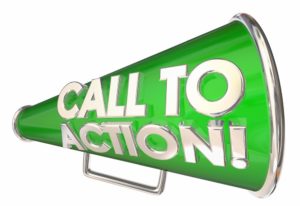
A Checklist For Creating an Effective Law Firm Website Call To Action

In case you’re not familiar with the term, a call to action (often abbreviated as CTA) is very much what it sounds like. It is a line of text or an image that calls upon readers to take some kind of action. It tells readers — or viewers — what you want them to do and asks them to do it.
Several seemingly small factors can have a big effect on how well your call to action does or doesn’t work. It’s not unusual to see big gains in conversions by doing something as simple as changing a few words or CTA placement on a page.
Following is a checklist you can use to be sure you get the absolute best results from any call to action you create for your marketing content.
Use Actionable Language
The words you use can have a big impact on the reader. Power words that people don’t see every day will make them curious to find out what’s on the other side of a link. Words that imply a personal benefit can also tip the scales in favor of a click.
You need to go beyond the commonplace phrases like “Click Here,” “Subscribe Now,” and “Find out more.” Think more along the lines of “Discover how to,” “Learn why,” and “Secure your place.”
Match CTA and Landing Page Language
A seamless user experience leads to better conversions. When you make sure that the language you use in your call to action matches what a reader sees on the landing page, you maintain the user experience. When a user clicks on a link, there should be absolutely no confusion as to what they are being presented with on the landing page.
For example, if your CTA promises a beginner’s guide to creating a will, the landing page should also call it a guide, not an ebook or a template or anything else. If the product description changes along the way, it leaves room for users to become confused and unsure, and this is exactly what you want to avoid in order to establish trust and maximize conversions.
Create a Sense of Urgency
By simply telling someone they need to do something now or that time will run out soon, you create a sense of urgency that many people can’t resist. There are several ways to do this without it becoming too much of a hard sell.
- Add the word “Now” to download or subscribe links
- Display a closing date/time for events like webinars
- Mention that something is a “Limited Offer”
- Point out that the reader can “reap the benefits today”
Words like now, today and limited can trigger a reaction from an otherwise passive reader.
Use Contrast in Your Design
A good call to action should stand out from other content on your web pages. It’s tempting to try to make everything neat and pretty so it fits in with the rest of your design, but this is exactly what you shouldn’t do.
You don’t need to make your CTA design the polar opposite of the rest of your page, but it should be put together in a way that makes it stand out from other text, logos and design elements on your pages. Before you’ll get any action, you need to get the reader’s attention.
Make it Look Like it Can Be Clicked
This is such a simple concept that many CTAs miss. Even though we’re looking at flat screens, people are used to clickable things looking like they’re clickable. If your CTA is text, make sure the clickable portion is a different color and has an underline. If it’s in a graphical format, the button should have some sort of shading that makes it look three dimensional and clickable.
It’s very simple. If people aren’t sure where they should click, they won’t click.
Test and Tweak Designs
An easy way to make sure your CTAs are always converting as best as they possibly can is to test different designs and variations. Once you have a CTA that you’re happy with, set up A/B testing and try variations on things like words, colors or placement on the page. As you find designs or variants that convert at a higher rate, you can continue to refine your call to action.
By making sure that the calls to action your law practice uses fit with the guidelines above, you should be able to maintain a higher than average conversion rate. And, with regular testing and tweaking, you’ll always know that your conversion rate is as high it can possibly be at any given time.
Are you ready to get started generating new, qualified leads?
Contact us to get started and let us help you energize your digital marketing and business development efforts.
Contact Us

